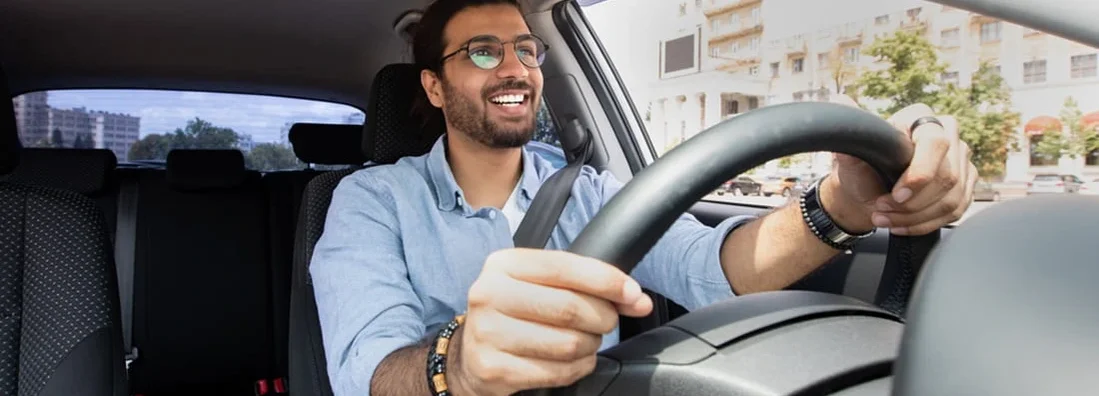Does Car Insurance Cover the Car or the Driver?

Jeff Green has held a variety of sales and management roles at life insurance companies, Wall street firms, and distribution organizations over his 40-year career. He was previously Finra 7,24,66 registered and held life insurance licenses in multiple states. He is a graduate of Stony Brook University.

Let’s say your car is in the shop and you borrow your friend’s car. Are you covered if you get into an accident? What about if someone borrows your car? Car insurance typically follows the car, meaning that the coverage is tied to the specific vehicle that’s insured, regardless of who’s driving it. However, some insurance can follow you when you drive a car that’s not listed in your policy. It’s important to understand the difference.
We’ll look at how car insurance works, what coverage best fits your needs, and how to get a policy through an independent insurance agent.
Does Car Insurance Follow the Car or the Driver?
Standard auto insurance policies are generally issued for a specific vehicle, so the coverage applies to that vehicle, in particular. Essentially, the insurance policy insures your vehicle and you, the driver of that vehicle.
What if someone else drives your car? If you give someone permission to drive your car, or if a driver is part of your household – like your son or daughter – they will be covered by your policy in most cases. That said, in some instances, the language in your policy may limit protections when someone else is driving your vehicle. For that reason, it’s always a good idea to check with the insurance company to verify your coverage.
The Times Car Insurance Follows the Car
Your policy covers your vehicle and you as the driver, and will usually cover someone else driving your car in these situations:
- You list the person on your auto insurance policy. This generally applies to family members.
- The person has your permission to drive your car, either with or without you in the vehicle.
Bear in mind that the amount of coverage a person driving your car receives varies both by state and the insurance company.
When won’t your policy cover someone else driving your car?
- You exclude a person from your policy. This could come into play if you’re worried that the person might get into an accident.
- A friend takes your car without your permission. In this situation, if your friend doesn’t have car insurance, your insurance may still cover any damage.
- Your car is being used for a rideshare app. In this case, you’d need rideshare insurance.
- You loan your car out through a paid car-sharing service. Your personal policy won’t cover this.
The Times Car Insurance Follows the Driver
When does your auto insurance follow the driver and not the car? If you rent a car for personal use, you will be covered.
This means you can skip buying extra insurance from the car rental company – although the agent may try to offer it to you.
However, if your personal policy only includes liability coverage, you may want to beef up your protection by purchasing additional rental car insurance that will pay for damage to your rental car if you get in an accident where you are at fault.
What Happens if Someone Borrows My Car and Gets in an Accident?
If you lend your car to someone and they get into an accident, is the damage covered? It depends on your policy.
If your policy allows you to give other people permission to drive your car (called “permissive use”), and you also have full coverage — which includes liability, collision, and comprehensive – your car will generally be protected under your policy.
On the other hand, if you only have liability coverage, your vehicle isn’t protected from damage no matter who is driving. However, if someone borrows your car and gets into an accident, your liability insurance should cover injuries or damages to the other driver in the accident.
Different Types of Car Insurance Coverage Options
When it comes to auto insurance, you have a few coverage options: liability only, collision, comprehensive, or full coverage (which includes all three).
Every state requires a minimum level of auto insurance. In most cases, this is typically liability insurance. (If you live in New Hampshire and choose to have auto insurance, you’ll need this coverage, as well.)
Liability insurance covers the costs associated with claims for bodily injury or property damage. Without it, if you cause an accident and injure someone else or damage their property – whether it’s a vehicle, fence, or something else – you could be sued. Liability insurance protects you.
If you want more protection, you can opt for full coverage, which provides protection for you – not just the other driver. It includes liability, collision, as well as comprehensive, and covers damage from the weather, an at-fault accident, hitting an animal, vandalism, and vehicle theft.
Let’s break it down:
| Type of Coverage | What it Covers |
|---|---|
| Bodily injury liability | Covers medical costs from an accident you caused |
| Property damage liability | Covers repair costs for property you damage in an accident |
| Uninsured motorist bodily injury liability | Covers medical costs from an accident with an uninsured driver |
| Uninsured motorist property damage coverage | Covers repair costs from an accident with an uninsured driver |
| Collision coverage | Covers repair costs to your car if you collide with another vehicle or an object like a tree |
| Comprehensive coverage | Covers repair costs from damage not caused by a collision with another vehicle, including weather, hitting an animal, theft and vandalism |
Because protections provided by auto insurance are limited to the insured car, what happens if you get into a wreck while driving a car that isn’t listed on your policy? In this situation, you shouldn’t expect your insurance to pay for the damage to that car, even if your policy included full coverage. However, rental cars might be an exception, depending on your policy.
Let’s look at a scenario where your liability coverage might be needed. For example, you’re driving your friend’s car and damage another vehicle in a collision. If the accident is your fault, your liability insurance might come into play if the damage exceeds the coverage limits in your friend’s policy.
Since they own the car, your friend’s policy would serve as the primary insurance. Your policy will act as secondary insurance if the damages exceed your friend’s coverage limits. Because different states have different laws regarding this, it’s a smart idea to check local regulations.
Getting the Right Insurance for Any Situation
Depending on the policy, the coverage you have when driving someone else’s car, or lending your car to someone, can vary dramatically. The exact terms of your policy, where you live, who’s driving, and the type of loss are all factors that determine whether or not you’re protected.
That’s why getting the right coverage for your individual needs is so important. Talk to an independent insurance agent who can give you a personalized quote and guide you through the insurance process.
https://www.thezebra.com/auto-insurance/insurance-guide/does-auto-insurance-follow-car-or-driver/
https://www.iii.org/article/auto-insurance-teen-drivers
https://www.iii.org/article/what-auto-insurance
https://www.iii.org/article/8-auto-insurance-myths
